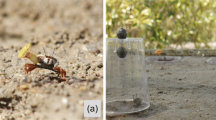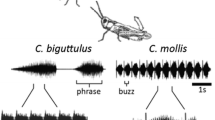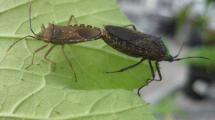Abstract
The biological species concept depends on mechanisms isolating reproduction to taxonomically define a species and to explain the disadvantages, and subsequent lack, of hybridization. In co-occurring tiger beetles (Carabidae: Cicindelinae), these between-species barriers are not readily apparent. To understand the characteristics potentially responsible for this isolation, we conducted behavioral and morphological experiments with two pairs of tiger beetle species. Choice trials showed males use visual cues to trigger the pursuit of potential mates and prefer females who appear similar in color. Geometric morphometric techniques allowed us to quantify shape differences in the mandibles of all four species. Previously, it was proposed that the mandible-coupling sulcus pairing acted as a lock-and-key mechanism to provide feedback necessary for species recognition. Our results, however, suggest that although there are significant differences in shape, these differences do not provide any feedback to the male or enhance his ability to retain his grasp on the female. Taken together, these findings suggest that vision, rather than the traditional mandibular lock-and-key hypothesis, may play a key role in reproductive isolation for co-occurring tiger beetle species.




Similar content being viewed by others
References
Acorn JH (1988) Mimetic tiger beetles and the puzzle of cicindelid coloration (Coleoptera: Cicindelidae). Coleopt Bull:28–33
Adams DC, Otárola-Castillo E (2013) Geomorph: an r package for the collection and analysis of geometric morphometric shape data. Methods Ecol Evol 4:393–399
Baldwin J, Johnsen S (2009) The importance of color in mate choice of the blue crab Callinectes sapidus. J Exp Biol 212:3762–3768
Barton NH, Hewitt GM (1985) Analysis of hybrid zones. Annu Rev Ecol Syst 16:113–148
Bates D, Maechler M, Bolker B, Walker S (2015) Fitting linear mixed-effects models using lme4. J Stat Softw 67:1–48
Bonduriansky R (2001) The evolution of male mate choice in insects: a synthesis of ideas and evidence. Biol Rev Camb Philos Soc 76:305–339. https://doi.org/10.1017/S1464793101005693
Brust ML, Knisley CB, Spomer SM, Miwa K (2012) Observations of oviposition behavior among north American tiger beetle (Coleoptera: Carabidae: Cicindelinae) species and notes on mass rearing. Coleopt Bull 66:309–314
Cassola F, Pearson DL (2000) Global patterns of tiger beetle species richness (Coleoptera: Cicindelidae). Biol Conserv 95:197–208
Eberhard WG (1985) Sexual selection and animal genitalia. Harvard University Press, Cambridge, MA
Eberhard WG (1996) Female control: sexual selection by cryptic female choice. Princeton University Press, Princeton, NJ
Ellers J, Boggs CL, Mallet J (2003) The evolution of wing color: male mate choice opposes adaptive wing color divergence in Colias butterflies. Evolution 57:1100–1106
Fielding K, Knisley CB (1995) Mating behavior in two tiger beetles, Cicindela dorsalis and C. puritana (Coleoptera: Cicindelidae). Entomol News 106:61–67
Freitag R (1974) Selection for a non-genitalic mating structure in female tiger beetles of the genus Cicindela (Coleoptera: Cicindelidae). Can Entomol 106:561–568
Freitag R (1966) The female genitalia of four species of tiger beetles (Coleoptera: Cicindelidae). Can Entomol 98:942–952. https://doi.org/10.4039/Ent98942-9
Freitag R, Olynyk JE, Barnes BL (1980) Mating behavior and genitalic counterparts in tiger beetles (Carabidae: Cicindelinae). Int J Invertebr Reprod 2:131–135
Goodall C (1991) Procrustes methods in the statistical analysis of shape. J R Stat Soc Ser B Methodol 53:285–339
Hochkirch A, Lemke I (2011) Asymmetric mate choice, hybridization, and hybrid fitness in two sympatric grasshopper species. Behav Ecol Sociobiol 65:1637–1645
Kronforst MR, Young LG, Kapan DD, McNeely C, O'Neill RJ, Gilbert LE (2006) Linkage of butterfly mate preference and wing color preference cue at the genomic location of wingless. Proc Natl Acad Sci 103:6575–6580
Lovari S, Favilli L, Eusebi MP, Cassola F (1992) The effects of prey movement, size and colour in the attack/avoidance behaviour of the tiger beetle Cephalota circumdata leonschaeferi (Cassola) (Coleoptera Cicindelidae). Ethol Ecol Evol 4:321–331
Masly JP (2012) 170 years of “lock-and-key”: genital morphology and reproductive isolation. Int J Evol Biol 2012:1–10. https://doi.org/10.1155/2012/247352
Morehouse NI, Rutowski RL (2010) In the eyes of the beholders: female choice and avian predation risk associated with an exaggerated male butterfly color. Am Nat 176:768–784
Paarmann W, Irmler U, Adis J (1982) Pentacomia egregia Chaud. (Carabidae, Cicindelinae), a univoltine species in the Amazonian inundation forest. Coleopt Bull 36:183–188
Palmer M (1976) Natural history and behavior of Pseudoxychila tarsalis Bates. Cicindela 8:61–92
Pearson DL (1985) The function of multiple anti-predator mechanisms in adult tiger beetles (Coleoptera: Cicindelidae). Ecol Entomol 10:65–72
Pearson DL (1988) Biology of tiger beetles. Annu Rev Entomol 33:123–147
Pearson DL, Cassola F (1992) World-wide species richness patterns of tiger beetles (Coleoptera: Cicindelidae): indicator taxon for biodiversity and conservation studies. Conserv Biol 6:376–391
Pearson DL, Mury EJ (1979) Character divergence and convergence among tiger beetles (Coleoptera: Cicindelidae). Ecology 60:557–566
Pearson DL, Vogler AP (2001) Tiger beetles: the evolution, ecology, and diversity of the cicindelids. Comstock Publishing Associates, Ithaca, NY
Pfennig KS (2007) Facultative mate choice drives adaptive hybridization. Science 318:965–967
R Development Core Team (2016) R: a language and environment for statistical computing. R Foundation for Statistical Computing, Vienna, Austria
Richardson RK (2013) Ecomorphology and Mating Behavior of Two Species of Night-stalking Tiger Beetles, Omus audouini and O. dejeanii. PhD Thesis, Portland State University
Rodríguez SRL (2000) Spermatophore transfer and ejection in the beetle Pseudoxychila tarsalis (Coleoptera: Cicindelidae). J Kans Entomol Soc 72:1–9
Rodríguez SRL (1998) Mating behavior of two Pseudoxychila beetles (Coleoptera: Cicindelidae). Can Entomol 130:775–750
Rohlf FJ (2012) tpsUtil, version 1.49. Department of Ecology and Evolution, State University of New York at Stony Brook
Rohlf FJ (1999) Shape statistics: Procrustes superimpositions and tangent spaces. J Classif 16:197–223
Schincariol LA, Freitag R (1986) Copulatory locus, structure, and function of the flagellum of Cicindela tranquebarica Herbst (Coleoptera, Cicindelidae). Int J Invertebr Reprod Dev 9:333–338
Schindelin J, Arganda-Carreras I, Frise E (2012) Fiji: an open-source platform for biological-image analysis. Nat Methods 9:676–682
Schultz TD (1986) Role of structural colors in predator avoidance by tiger beetles of the genus Cincindela (Coleoptera: Cincindelidae). Bull Entomol Soc Am 32:142–146
Veen T, Borge T, Griffith SC, Saetre GP, Bures S, Gustafsson L, Sheldon BC (2001) Hybridization and adaptive mate choice in flycatchers. Nature 411:45–50
Acknowledgments
We would like to thank the undergraduates involved in specimen collection for this project as well as the volunteers and staff at the Southwestern Research Station.
Funding
This material is based upon work supported by the National Science Foundation Graduate Research Fellowship Program under grant no. 1452598.
Author information
Authors and Affiliations
Corresponding author
Ethics declarations
Conflict of Interest
The authors declare that they have no conflict of interest.
Electronic supplementary material
ESM 1
(DOCX 183 kb)
Rights and permissions
About this article
Cite this article
Jones, T.K., Conner, W.E. Pre-Mating Reproductive Isolation in Tiger Beetles (Carabidae: Cicindelinae): an Examination of the Role of Visual and Morphological Feedback. J Insect Behav 31, 672–688 (2018). https://doi.org/10.1007/s10905-018-9704-y
Received:
Revised:
Accepted:
Published:
Issue Date:
DOI: https://doi.org/10.1007/s10905-018-9704-y




